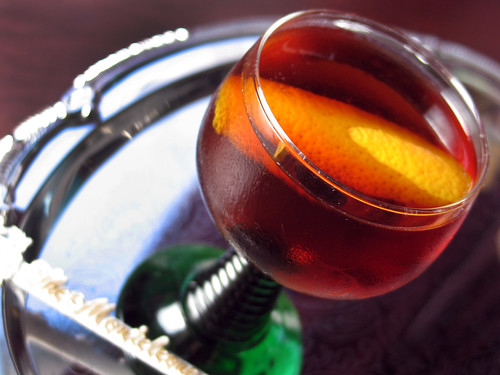The Rue Royale Cocktail
Here’s my entry in the Monteleone Hotel’s cocktail competition — the hope is that this drink gets to be called “The Monteleone Cocktail” for good. As you may recall from previous posts over the past couple of weeks, the Monteleone Hotel in New Orleans is hosting a cocktail contest for their new signature drink, in honor of the 60th anniversary of their legendary and venerable Carousel Bar. The competition will no doubt be as stiff as the drinks, so wish me luck!
While I wasn’t really using the hotel’s other signature drink, the Vieux Carré, as a jumping-off point, I did want to have rye as a base spirit. As it turned out, there’s a slight similarity between the drinks in some of the proportions, but this goes off in a different direction, with a balance of bitter and sweet and spicy and malty that Wes and I both really liked. Here’s hoping you like it too (not to mention the contest judges!).
The Monteleone Cocktail
(Tentatively named pending cocktail contest results.)Rue Royale
(Renamed, as another cocktail was chosen for the contest winner)1 ounce Sazerac Rye (6 Year).
1 ounce Bols Genever.
1 ounce Dolin Vermouth Blanc.
1/2 ounce Averna.
2 dashes Peychaud’s Bitters.
1 dash Regans’ Orange Bitters No. 6.
Orange peel.Combine ingredients with cracked ice and stir for 30 seconds. Strain into a chilled cocktail coupe and garnish with the orange peel after giving it a mighty twist.
The rye is there to provide a solid foundation of whiskey and spice, and is there for New Orleans. I was fascinated by the combination of whiskey and genever, which the malty, whiskey-like characteristic of this genever in particular. (My original idea was to try this with Ransom Old Tom Gin, a new barrel-aged Old Tom co-developed by David Wondrich, which I tasted in Seattle and went mad for, but it’s not available yet.) I wanted an aromatized wine as a moderator, and the newly-imported Dolin Blanc is a fantastic product I’ve fallen completely in love with. It’s a sweet white vermouth, along the lines of a bianco from Cinzano or Martini & Rossi but with a really tremendous flavor, and with the sweetness held back a bit. The Averna is because I love amaro, because wanted a pleasantly bitter element which the Dolin helps balance well, and also to honor the Sicilian heritage of Signor Antonio Monteleone, the founder of the hotel. Peychaud’s for spice and for the city, and as I was trying out early incarnations and got close, we thought it needed one little extra bit of brightness, which the orange bitters provide.
Well, that’s my story, anyway, and I’m sticking to it.
If it doesn’t win I’ll still keep making it, and it’ll just get renamed. Maybe I’ll call it the Antonio, after Signor Monteleone. But let’s not get ahead of ourselves; I’d rather it be called the Monteleone.
UPDATE, 5/22/2009: Alas, another cocktail won the contest, but I think this drink is a keeper. It’s being renamed the “Rue Royale.” (Thanks to Wes for the name suggestion!) And congratulations to contest winner Brian Robinson of The Wormwood Society.







